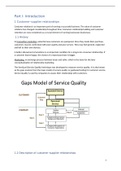Samenvatting
Samenvatting Customer Relationship Management
Peelen, Ed & Beltman Rob (2013) Customer relationship management (2nd edition). Chapters: 1,2,3,4,5,6,7,8,9,11,12,13,16,17 Visser M & Slikkenga (2018) Digital markerting fundamentals paragraphs: 10.1.4, 10.2, 10.3, 10.4, 10.5, 13.4.1 and 13.4.2
[Meer zien]





